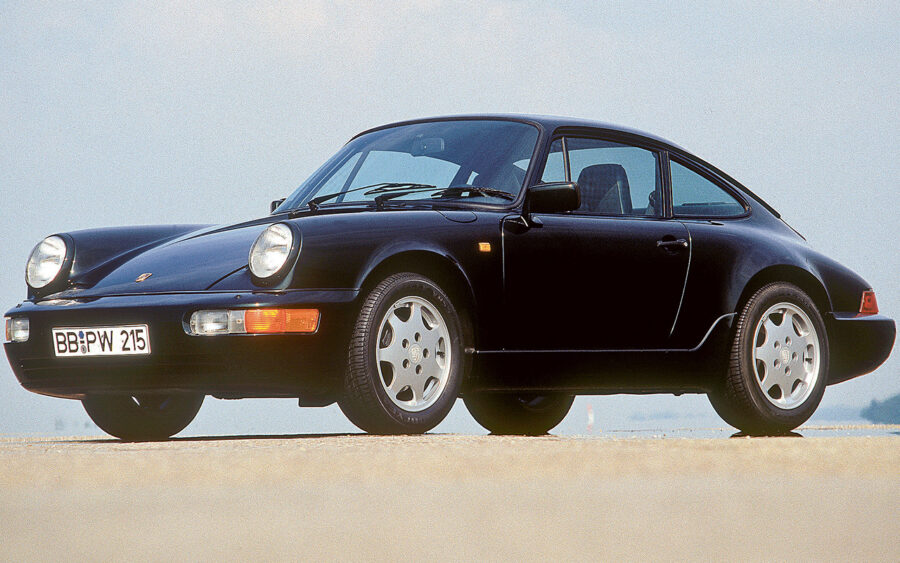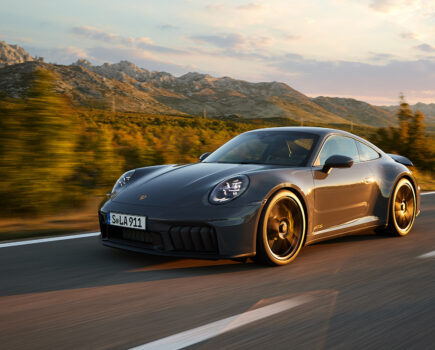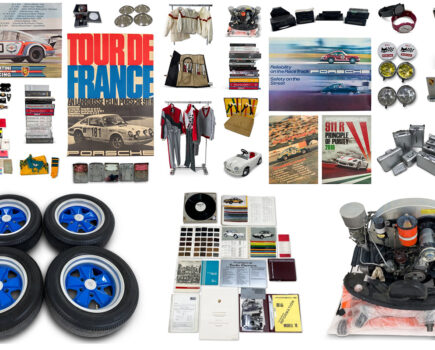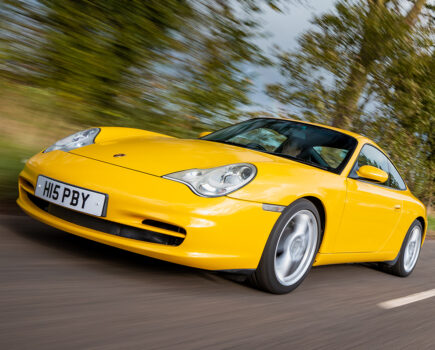Shaped by a changing financial climate and the whims of speculators, the 964 helped kickstart a burgeoning air-cooled restomod market
Words: Jon Burgess
The world was not what it once was; as the 80s ended, the world was falling out of love with Porsche – and the generous exchange rate it had enjoyed with the United States and the rest of Europe was coming to an endConceived as far back as 1984, when things were very rosy indeed for Porsche, the ‘K’ Series 911 (known as ‘964’ within Weissach) could have been far more radical than history recorded, but the chilling effect of the economy urged caution upon management.
To that end, the ‘K’-letter cars owed a fair bit to their earlier-lettered counterparts; the wings, headlights and roof panel were retained, but 87 per cent of the panels, aerodynamically shaped to lower the drag coefficient, were new. As resto-modders would discover in the 2000s, however, this made the 964 easy to transform; narrow-hipped and relatively light, it could be made to resemble the earlier, prettier ‘alphabet’ 911s with minimal amounts of fabrication and tooling costs.
During the 964’s development, smoothed impact bumpers, flush fitting glass, reprofiled valances fore and aft, and new undertrays helped achieve a 0.32 target, alongside a modified floor pan. To tackle rear lift, the iconic Carrera 2.7 RS ‘ducktail’ was considered, but instead, a new speed-sensitive electric spoiler was developed. It rose automatically over speeds of 50mph; for the 911, whose side profile resembled a giant wing at the best of times, it was a boon.
The restraint of Porsche’s engineers and board was considerable, given the technical expertise it had built up during the 959 programme; owing to financial worries, its successor, the 969 (otherwise designated 965) was canned during 964 development after 16 prototypes were built. Intended to sit alongside the 964, it would have used a water-cooled, 3.5-litre flat-six, and all-wheel-drive; water-cooled V6s and V8s were also tried. Too much, too soon: instead, the 911 Carrera 4 (C4), with a 31:69 front-rear bias, released first in 1989.
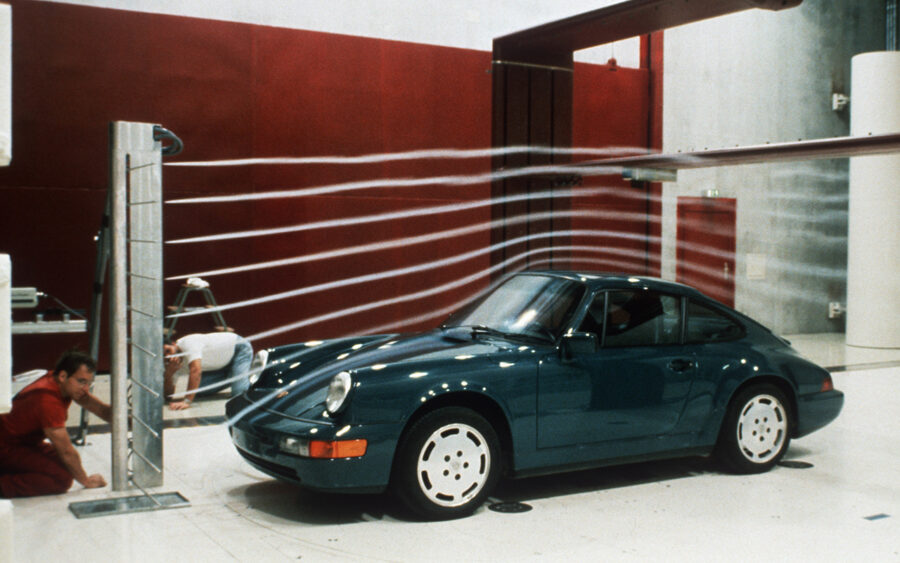
Using running gear derived from the four-wheel-drive Paris-Dakar Rally 911 (953), and an all-new ‘G64’ gearbox, it put paid to the challenging, sometimes wayward nature of earlier 911s, which sometimes snared the unwary. Its rearward bias retained much of the feel endemic to the 911’s rear-engine, rear-drive layout; furthermore, ABS was standard for the first time. Times were changing, and the 911’s rivals were getting more user-friendly.
Porsche’s classic torsion bar rear suspension was ousted in favour of coil springs and semi-trailing arms to make everything fit in the Carrera 4; it should have launched a year prior, but spiralling weight gains (227kg over the outgoing Carrera 3.2) and performance targets delayed the new car’s arrival.
In the end, there was nothing for it but to bore and stroke the Carrera 3.2’s engine, itself a development of the earlier 3.0 SC unit claimed as an 80 per cent update by Porsche in period. The new motor, dubbed ‘M64’, displaced 3,600cc and produced 250bhp in comparison to the outgoing 3.2’s 231bhp; twin plug heads allowed it to meet Californian emissions after a lot of trial-and-error testing. By September 1989, the 100kg lighter Carrera 2 (C2) had also debuted as 1990 model year cars, followed shortly by Cabriolet and Targa models.
Amid this turmoil Ferry Porsche turned 80, and to celebrate, a one-off 964 called the Panamericana was built, its wild, scalloped wings and huge tyres unlike any other 911; part dune-buggy, part Coupe Fiat in appearance. A year later, a specially trimmed C4 was given as a birthday present to Ferry’s sister, Louise Piëch, once managing director of Porsche Holding Austria and latterly an honorary chair of Porsche’s supervisory board. Both it and the Panamericana survive to this day, the former in private hands, the latter in the Porsche Museum.
There had been no time to develop a 964 Turbo in the rush to get the C2 and C4s to market, but, as a poster child for Porsche, the absence of a wide-bodied, whale-tailed 911 Turbo would have cost the firm dearly in the long run. Engineers reverted back to the 930 Turbo’s 3.3-litre M30/69 engine in ‘Sportkit’ trim. Though it needed modifications to accept catalytic convertors, it made 330bhp, equal to that of the 930’s ‘Sportkit’ engine while meeting the latest emissions requirements. Production began in September 1990 for the 1991 model year, during which time Porsche’s annual sales had shrunk by two-thirds.
A looming recession had dimmed enthusiasm for standard models (i.e the C2 and C4, and, to a lesser extent the Turbo), but the firm had other means with which to raise cash: limited runs of hardcore road and race cars to interest enthusiasts and speculators alike. It was a creative way of keeping the lights on while enticing collectors in the United States, who clamoured for faster, more powerful and exclusive 911s.
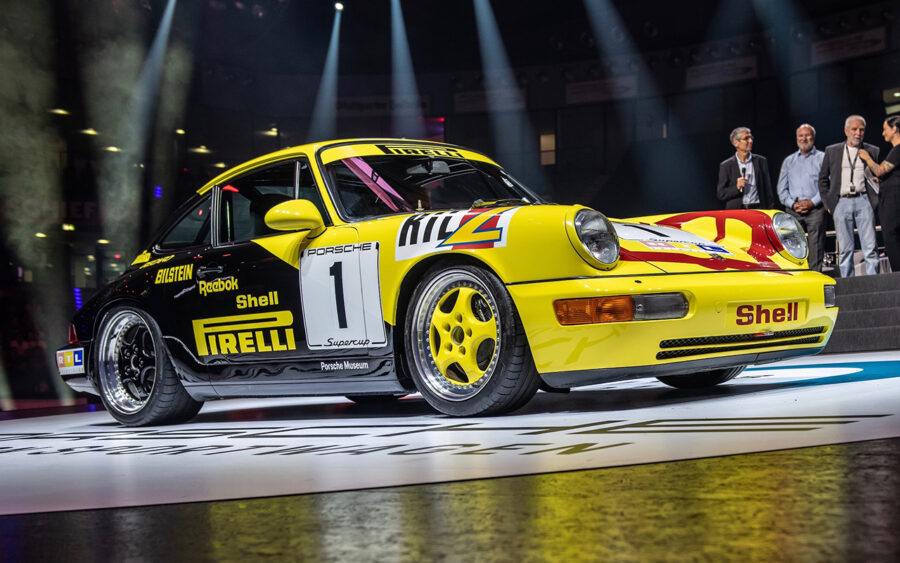
1990 had also seen the launch of the Carrera Cup (above), a one-make, soon-to-be worldwide race series for the 964 which begat the Supercup, a support series for Formula 1. The Porsche 944 Cup had existed since 1986; the Carrera Cup, exclusively for the 964, was considerably more prestigious. Production 964 C2s were stripped, caged, lowered and given a limited-slip differential; the 3.6-litre ‘M64’ was pushed out to 265bhp, and 50 cars were produced in the initial run.
An early attempt to corner the speculator market ran alongside the Cup cars; 22 track-only 911 Carrera 4 Lightweights were produced as a means of using up the spare sets of 953 Paris-Dakar four-wheel-drive running gear, allowing drivers to adjust drive bias from front-to-rear, and left-to-right. Nearly 350kg of weight was removed from the Carrera 4 body using Plexiglass and thin-gauge aluminium; tweaked electronics and a minimally baffled stainless-steel exhaust liberated 265bhp. Its high purchase price, more than double than that of the Carrera Cup cars, didn’t put buyers off.
Meanwhile, faster 964s were on their way. At the 1991 Geneva Motor Show, the ‘RS’ nameplate returned to the rump of a 911 for the first time since the Carrera 2.7 RS of 1973; the dual purpose (road and track) RS was slated for a 1000-unit run, and quickly sold out (1051 were sold in 1991, followed by 1352 in 1992). It was the 964 at its best, borrowing parts from the Carrera Cup and Turbo parts bins; the former donated its 17-inch magnesium wheels, the latter parts of its braking system. Almost all creature comforts were thrown out, including the rear seats, reducing weight to 1240kg; with the catalysts deleted, the 3.6-litre engine gave 260 bhp. The stiffer, seam welded shell had a front strut brace, and stiffened, 40mm lower suspension with aluminium hubs. Buyers could go further, if they wished: N-GT and Carrera Cup eligible RSs, if specified, could be sold with a roll cage, harnesses (with belts colour-coded to the car’s body), a fire suppression system, and a battery cut off circuit.
By 1992, the RS had received another derivation, built by the Exclusive department and known as the 3.3 Turbo S Lightweight, derived directly from that year’s Turbo S. As its name implied, the model was a combination of RS and Turbo S parts; the RS gave its progressive rate springs, Bilstein dampers, aluminium hubs, front strut brace and brakes (complete with red calipers for the first time), on 18-inch Speedline wheels, while the Turbo’s wide body was stiffened, lightened and reinforced.
Power was provided by the 3.3-litre M30/69 engine from the Turbo S; work to the heads, different duration camshafts, and a large, faster spooling turbocharger setup bumped power from 320bhp to 381bhp. Porsche had another hit on its hands: from a planned 80 car run, 86 were eventually produced, and used as the basis for which to homologate the Turbo S LM racing car of 1993.
Buyers in the United States watched in amazement as they were denied the RS by Porsche Cars of North America, judging it too harsh and non-compliant with Federal safety standards. However, American Porsche fans were to receive two special models by way of compensation: the America Roadster, celebrating 40 years of the 1952 356 by the same name (sold as the Turbo Look Cabriolet in Europe, with C2 running gear but with Turbo arches and brakes) and the (1993) RS America, a lightened, simplified C2 with Sport suspension, 17-inch Cup wheels, and a whale tail rear spoiler. Competitively priced, below that of a standard C2, 701 were sold. To add insult to injury, 45 American-specification RS cars were completed for a stillborn round of the US Carrera Cup; it would have supported Indycar but no sponsors were found. To avoid competition with the RS America, these cars were identified by a special dashboard plaque which called the model the ‘Carrera Cup US Edition.’
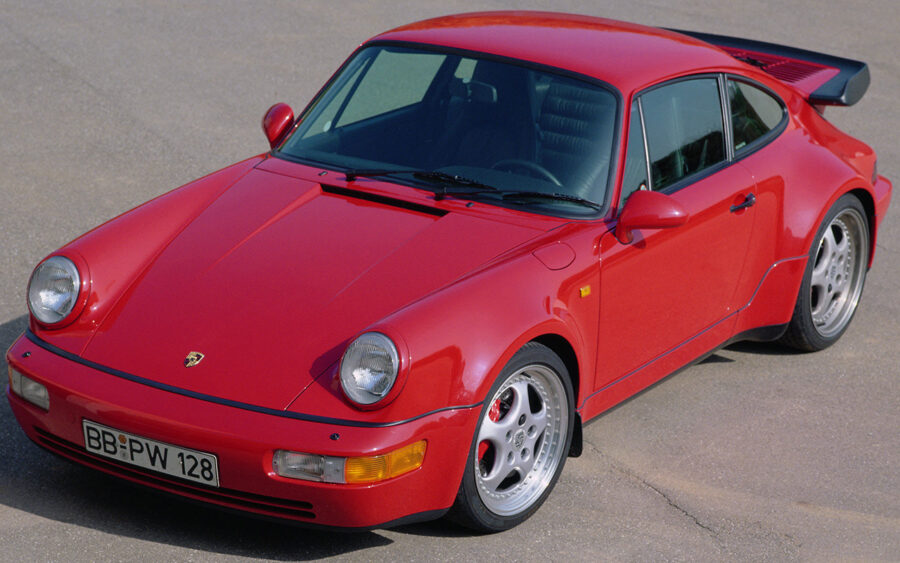
The 911 nameplate was 30 years by 1993 – and to celebrate, a special 30th Anniversary (’30 Jahre’) car was released, based on the Turbo wide body that did without that car’s whale tail, instead using the speed-sensitive spoiler used on standard C2s and C4s, as per the America Roadster. Running gear was from the C4, with a standard 3.6-litre M64 engine.
Speaking of the M64, it was finally turbocharged in 1993 for a limited year run of cars. Now with 360bhp, fewer than 1500 were built as production wound down in favour of the 964’s successor, the 993. Another storied name plate from the 356 days, the Speedster, was also revived for a second time in 1993, following a limited run of 930 derived, 3.2-litre cars in 1989 just before the 964 was launched. 1993’s Speedster was similarly uncompromising: a narrow bodied, limited edition based on C2 running gear that was a dynamic compromise between a Cabriolet and an RS.
Porsche’s race department hadn’t stood still, either: to homologate the RS for endurance racing, the ‘street’ RS 3.8 and ‘race’ RSR 3.8 were born; increasing the cylinder bore from 100mm to 102mm had the desired effect, producing 300bhp in the street cars inside a gutted, lightened shell with aluminium panels.
1994 brought one final surprise for 964 fans: a limited, 90-car run of Turbo 3.6 S models to use up the remaining shells and drivetrains. Porsche Exclusive – they of the Turbo 3.3 Turbo S Lightweight – rose to the task, offering customers a ‘flachbau’, or ‘slant nose’ (Turbo SE) package, recalling the expensive and sought-after 930 option of 1986. 76 buyers took the plunge, ushering the 964 into the history books in a powerful, whale-tailed, oversteer-led fashion.
Porsche lived to fight another day through resourcefulness; while the C2 and C4 964s remain the least desirable of the air-cooled, flat-six 911s, their relatively low value and close relationship with letter models of old gave the resto-modding community – kick-started by Singer in 2009 – a foothold from which to operate. While the market may not regard the standard 964 with much fondness, the likes of Singer, Theon, Rennsport, Everrati and Evomax would surely disagree.
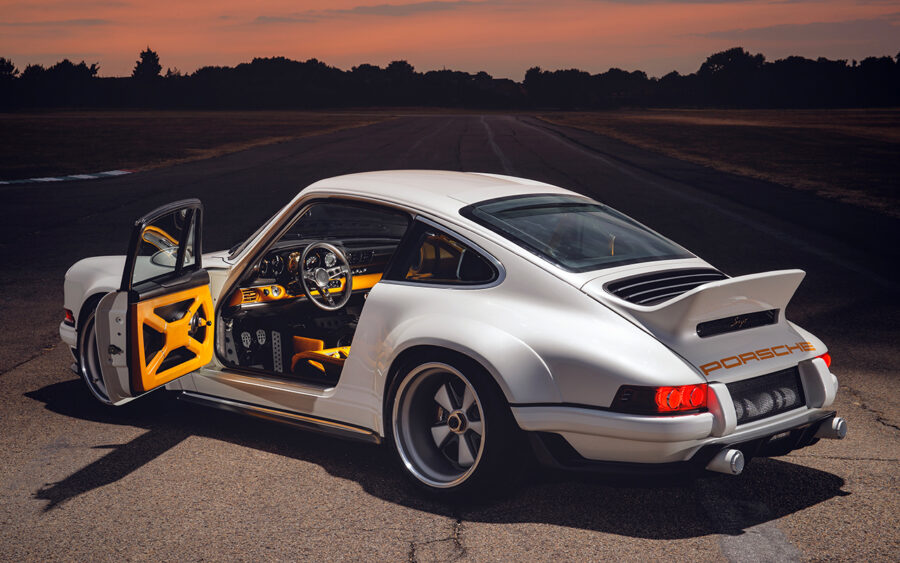
1989 – K Series
964 debuts in Carrera 4 (C4 form), with 3.6-litre ‘M64’ engine. Carrera 2 arrives a few months later. 87 per cent new body, with flush bumpers, fog lights, and speed-sensitive spoiler.
1990 – L Series
Clutchless Tiptronic ‘Typ A’ 50/01 gearbox unveiled; operable in semi and full automatic modes, spiritual successor to 1967-1978 Sportomatic semi-auto.
C2 and C4 Cabriolet and Targa body styles released.
Carrera Cup race series created, based on C2 road car.
1991 – M Series
Driver and passenger airbags now standard.
Turbo released, using uprated M30 engine from 930.
RS debuts at Geneva; lightened body with 3.6-litre engine.
Limited run C4 Lightweight released; 3.6-litre engine, stripped out body, 953 four-wheel drive running gear.
1992 – N Series
Porsche Exclusive releases 3.3 Turbo S Lightweight; 86 made.
America Roadster commemorates 40 years of 356 America Roadster; sold as Turbo-Look Cabriolet in
Europe; Turbo brakes and body but C2/C4 speed-sensitve spoiler instead of whale-tail.
Limited-run RS Competition launched.
381bhp, limited-run Turbo S debuts – an IMSA homologation special, ultimate variant of the 3.3 M30 engine.
1993 – M Series
911 ’30 Jahre’ commemorative edition launched; Turbo wide body with C4 running gear.
Speedster and Speedster Turbo Look brings back the Speedster name for the third time.
Turbo Cabriolet finally arrives.
Turbo 3.6, with 360bhp on sale. Tuning package offers 385bhp.
Turbo S2 – a US certified, 322bhp Turbo S – released.
M64 engine bored out to create the RS 3.8 (300bhp) and RSR 3.8 for endurance racing.
1994 – N Series
Carrera 4 ‘Wide Body’ offered in US, sold as ‘Turbo look’ in rest of world; it, Turbo S2 and ’30 Jahre’ are the last ‘standard’ 964 variants on sale.
Porsche Exclusive takes the last 90 Turbo 3.6 bodies, creating the Turbo 3.6 S. ‘Package’ (standard nose) and ‘Flachbau’ (flat nose) models offered; 14 standard nose and 76 flat nose cars produced.
66,571 units produced, including all variants of 964.

